Abstract
In vivo administration of cobra factor (CoF) the C3-activating protein of cobra venom, had no suppressive effect on the in vitro response of lymphocytes to PHA, LPS or allogeneic cells; nor did it affect the generation of cells cytotoxic to allogeneic target cells. HVG reactivity was inhibited by commercially available but not purified CoF, and the latter also failed to prolong skin allograft survival. It is concluded that in vivo complement depletion does not interfere with T cell responses, and that previous reports of prolonged survival of skin allografts and inhibition of cutaneous delayed hypersensitivity reactions following treatment with CoF may have been due to impurities in the preparations used.
Full text
PDF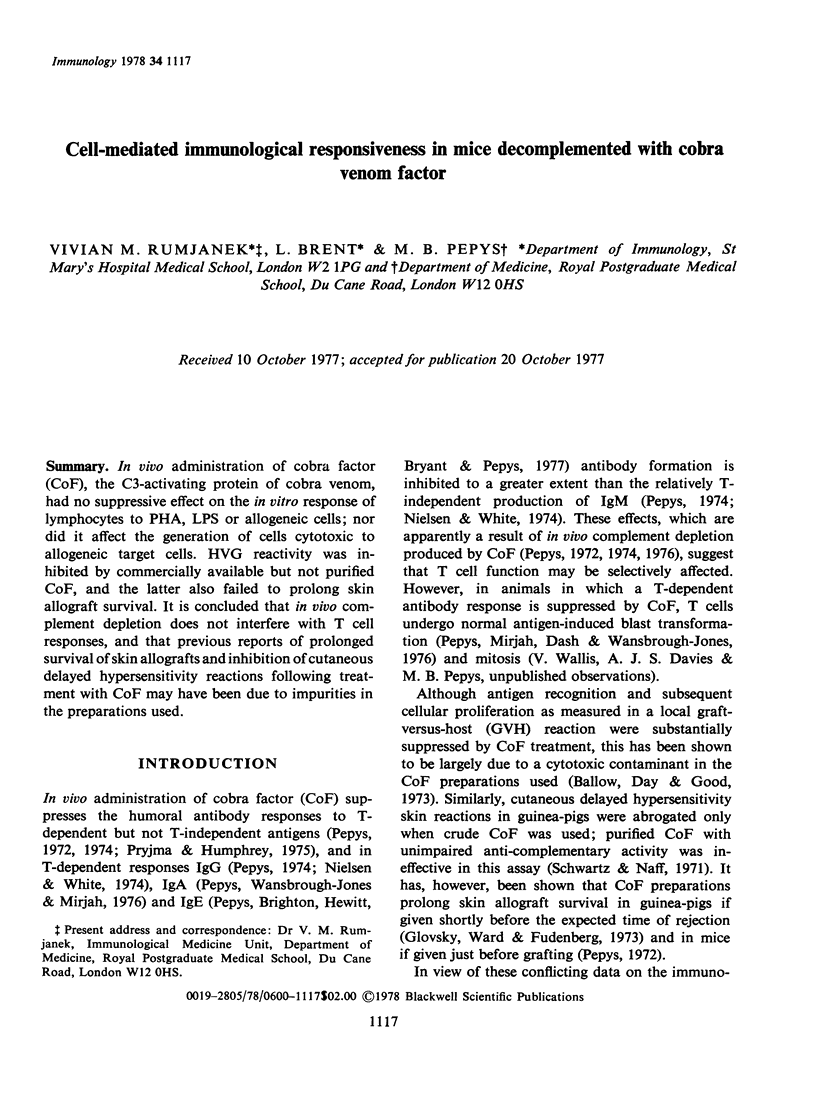
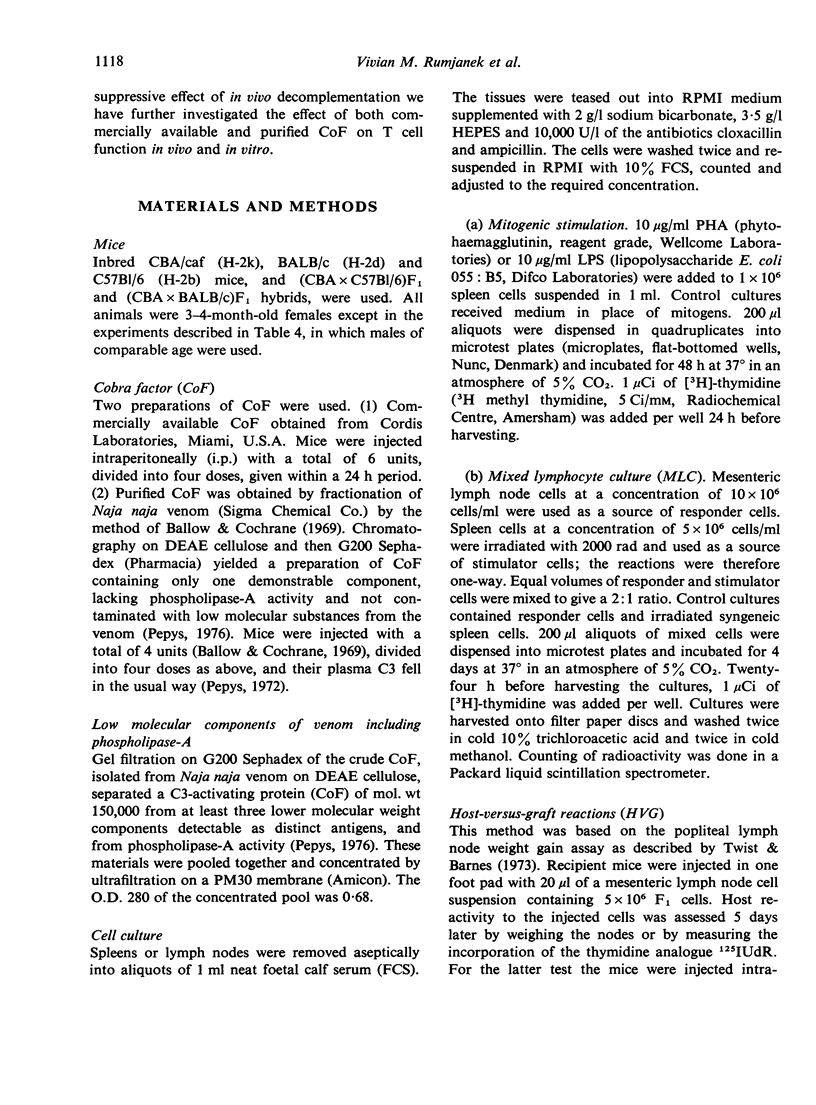

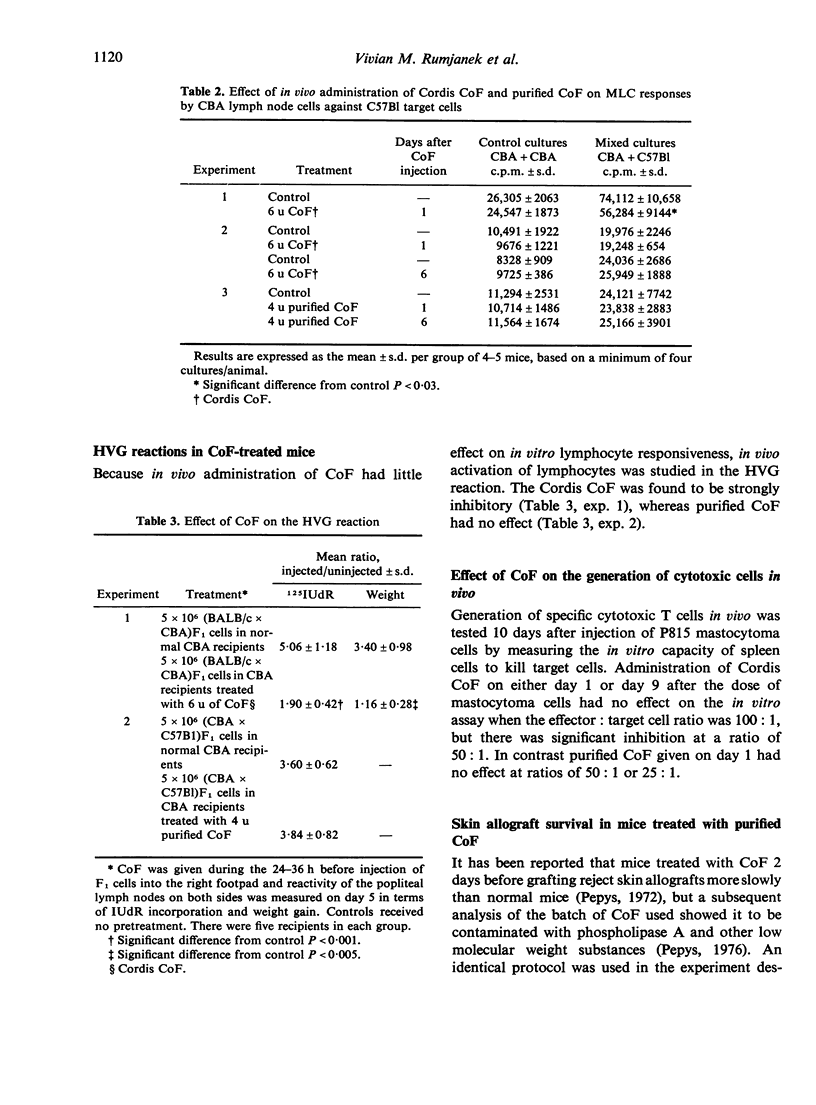
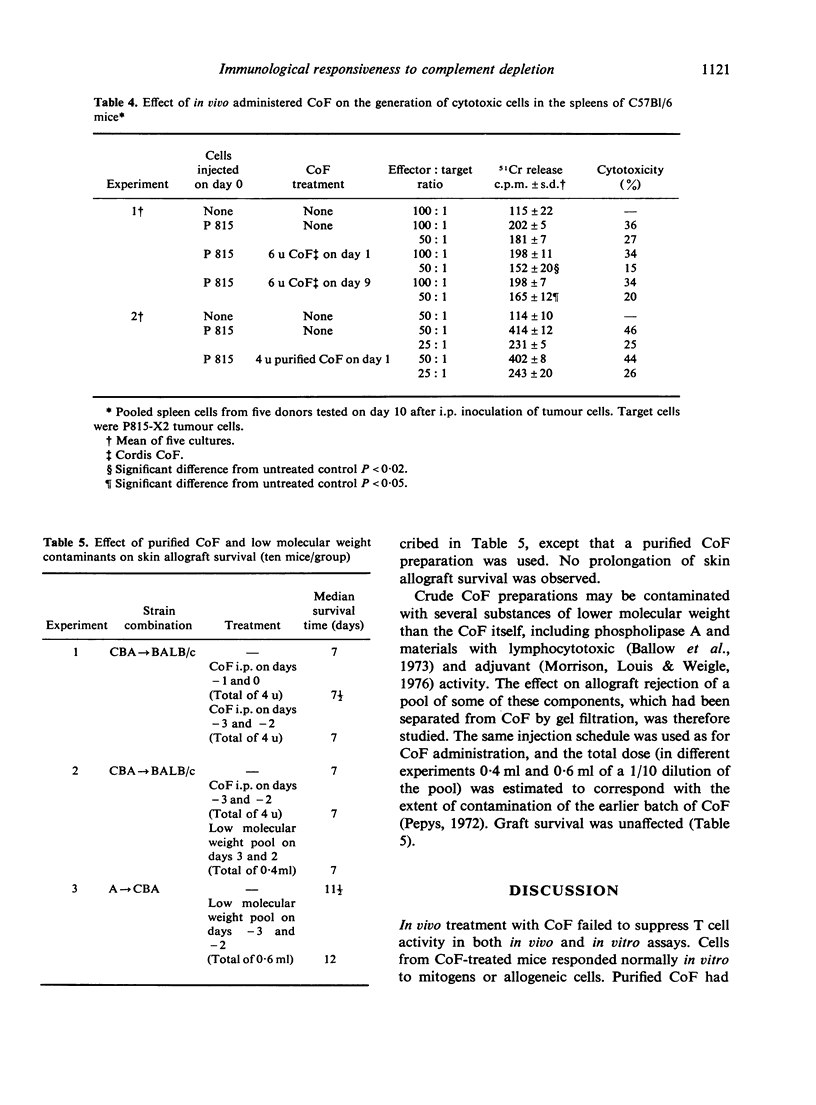
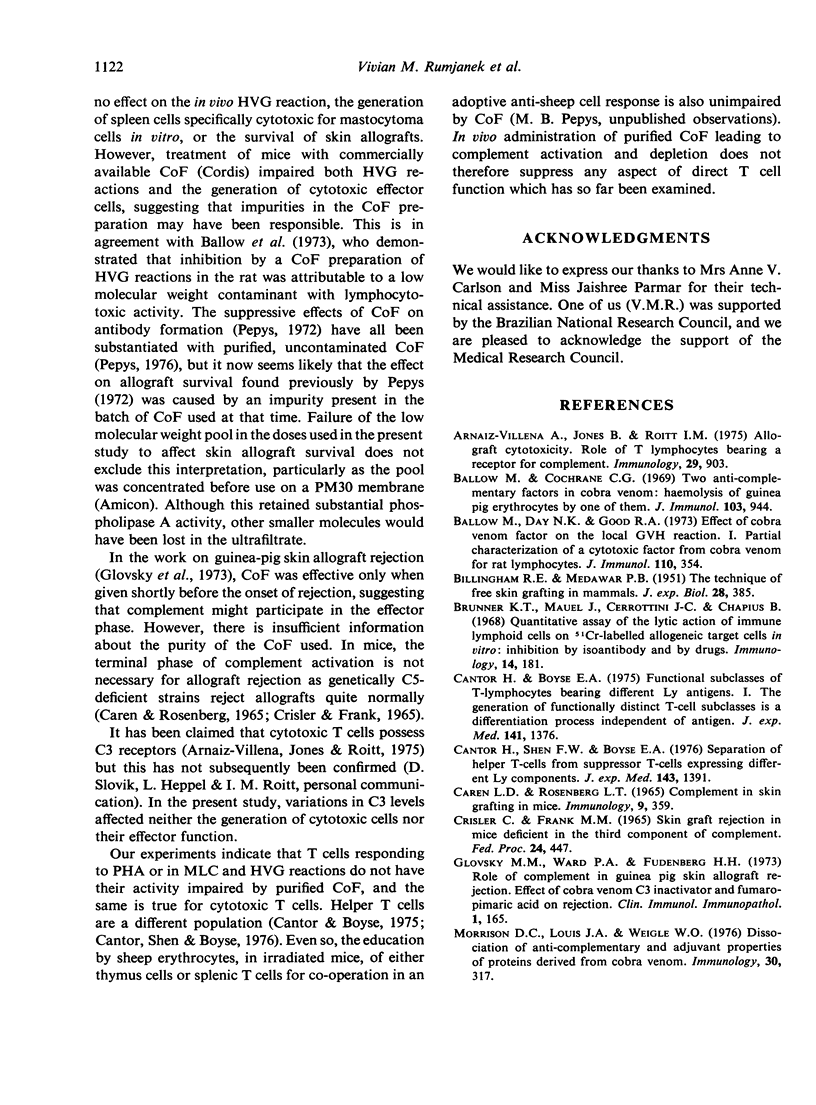
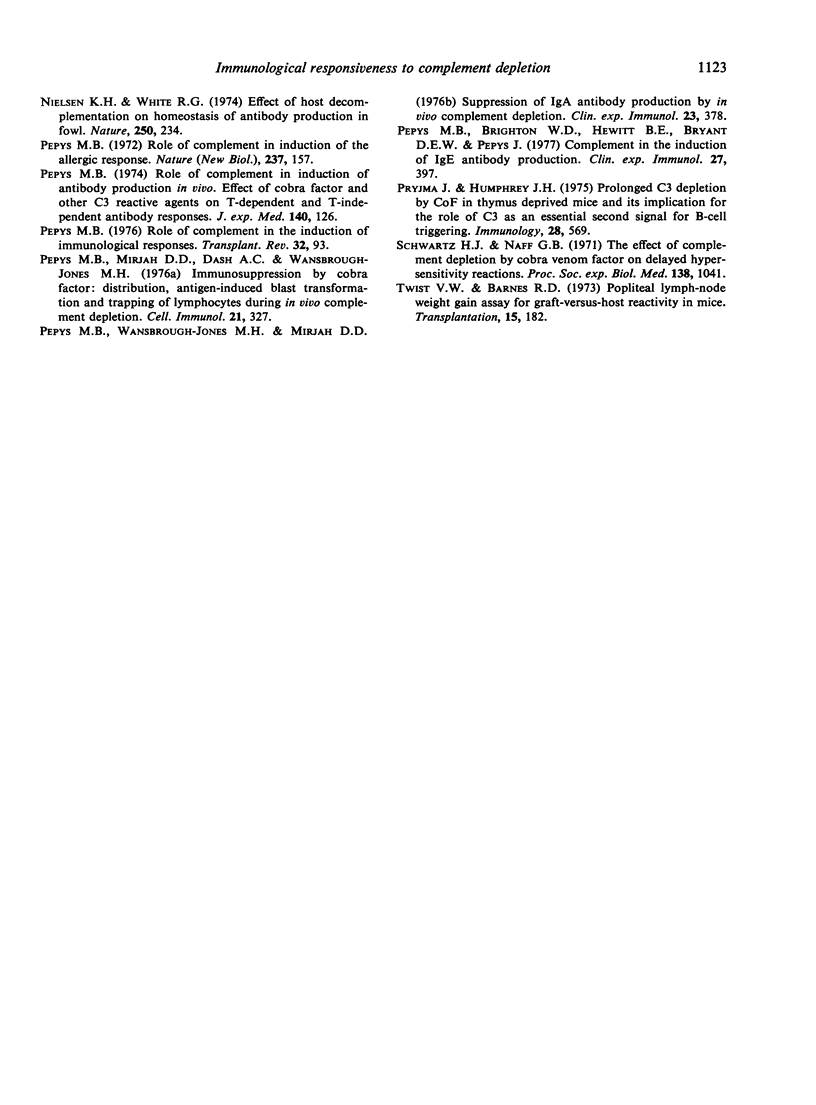
Selected References
These references are in PubMed. This may not be the complete list of references from this article.
- Arnaiz-Villena A., Jones B., Roitt I. M. Allograft cytotoxicity. Role of T lymphocytes bearing a receptor for complement. Immunology. 1975 Nov;29(5):903–908. [PMC free article] [PubMed] [Google Scholar]
- Ballow M., Cochrane C. G. Two anticomplementary factors in cobra venom: hemolysis of guinea pig erythrocytes by one of them. J Immunol. 1969 Nov;103(5):944–952. [PubMed] [Google Scholar]
- Ballow M., Day N. K., Good R. A. Effect of cobra venom factor on the local GVH reaction. I. Partial characterization of a cytotoxic factor from cobra venom for rat lymphocytes. J Immunol. 1973 Feb;110(2):354–361. [PubMed] [Google Scholar]
- Brunner K. T., Mauel J., Cerottini J. C., Chapuis B. Quantitative assay of the lytic action of immune lymphoid cells on 51-Cr-labelled allogeneic target cells in vitro; inhibition by isoantibody and by drugs. Immunology. 1968 Feb;14(2):181–196. [PMC free article] [PubMed] [Google Scholar]
- Cantor H., Boyse E. A. Functional subclasses of T-lymphocytes bearing different Ly antigens. I. The generation of functionally distinct T-cell subclasses is a differentiative process independent of antigen. J Exp Med. 1975 Jun 1;141(6):1376–1389. doi: 10.1084/jem.141.6.1376. [DOI] [PMC free article] [PubMed] [Google Scholar]
- Cantor H., Shen F. W., Boyse E. A. Separation of helper T cells from suppressor T cells expressing different Ly components. II. Activation by antigen: after immunization, antigen-specific suppressor and helper activities are mediated by distinct T-cell subclasses. J Exp Med. 1976 Jun 1;143(6):1391–1340. doi: 10.1084/jem.143.6.1391. [DOI] [PMC free article] [PubMed] [Google Scholar]
- Caren L. D., Rosenberg L. T. Complement in skin grafting in mice. Immunology. 1965 Oct;9(4):359–364. [PMC free article] [PubMed] [Google Scholar]
- Glovsky M. M., Ward P. A., Fudenberg H. H. Role of complement in guinea pig skin allograft rejection. 1. Effect of cobra venom C3 inactivator and fumaropimaric acid on rejection. Clin Immunol Immunopathol. 1973 Jan;1(2):165–172. doi: 10.1016/0090-1229(73)90016-0. [DOI] [PubMed] [Google Scholar]
- Morrison D. C., Louis J. A., Weigle W. O. Dissociation of anticomplementary and adjuvant properties of proteins derived from cobra venom. Immunology. 1976 Mar;30(3):317–323. [PMC free article] [PubMed] [Google Scholar]
- Nielsen K. H., White R. G. Effect of host decomplementation on homeostasis of antibody production in fowl. Nature. 1974 Jul 19;250(463):234–236. doi: 10.1038/250234a0. [DOI] [PubMed] [Google Scholar]
- Pepys M. B., Brighton W. D., Hewitt B. E., Bryant D. E., Pepys J. Complement in the induction of IgE antibody formation. Clin Exp Immunol. 1977 Mar;27(3):397–400. [PMC free article] [PubMed] [Google Scholar]
- Pepys M. B., Mirjah D. D., Dash A. C., Wansbrough-Jones M. H. Immunosuppression by cobra factor: distribution, antigen-induced blast transformation and trapping of lymphocytes during in vivo complement depletion. Cell Immunol. 1976 Feb;21(2):327–336. doi: 10.1016/0008-8749(76)90060-5. [DOI] [PubMed] [Google Scholar]
- Pepys M. B. Role of complement in induction of antibody production in vivo. Effect of cobra factor and other C3-reactive agents on thymus-dependent and thymus-independent antibody responses. J Exp Med. 1974 Jul 1;140(1):126–145. doi: 10.1084/jem.140.1.126. [DOI] [PMC free article] [PubMed] [Google Scholar]
- Pepys M. B. Role of complement in induction of the allergic response. Nat New Biol. 1972 May 31;237(74):157–159. doi: 10.1038/newbio237157a0. [DOI] [PubMed] [Google Scholar]
- Pepys M. B. Role of complement in the induction of immunological responses. Transplant Rev. 1976;32:93–120. doi: 10.1111/j.1600-065x.1976.tb00230.x. [DOI] [PubMed] [Google Scholar]
- Pryjma J., Humphrey J. H. Prolonged C3 depletion by cobra venom factor in thymus-deprived mice and its implication for the role of C3 as an essential second signal for B-cell triggering. Immunology. 1975 Mar;28(3):569–576. [PMC free article] [PubMed] [Google Scholar]
- Schwartz H. J., Naff G. B. The effect of complement depletion by cobra venom factor on delayed hypersensitivity reactions. Proc Soc Exp Biol Med. 1971 Dec;138(3):1041–1043. doi: 10.3181/00379727-138-36046. [DOI] [PubMed] [Google Scholar]
- Twist V. W., Barnes R. D. Popliteal lymph node weight gain assay for graft-versus-host reactivity in mice. Transplantation. 1973 Jan;15(1):182–185. doi: 10.1097/00007890-197301000-00028. [DOI] [PubMed] [Google Scholar]


